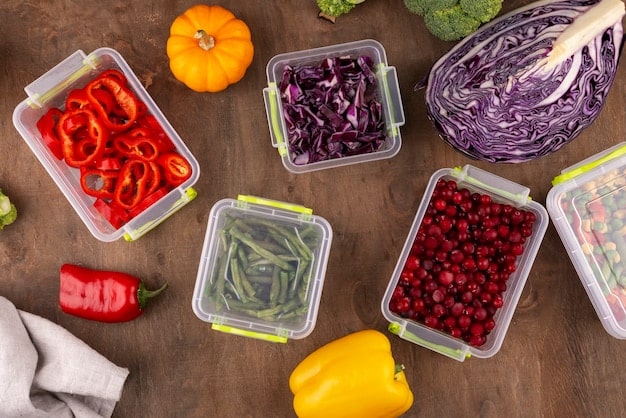Meal Planning for Picky Eaters: Reduce Waste by 20%

Meal planning for picky eaters can significantly reduce food waste by 20% through strategies like introducing new foods gradually, involving kids in the planning process, and repurposing leftovers creatively, making meal times less stressful and more eco-friendly.
Navigating meal times with picky eaters can be challenging, often leading to frustration and wasted food. Implementing effective meal planning for picky eaters can not only simplify your life but also help reduce food waste by up to 20%, creating a more sustainable and enjoyable dining experience for the whole family.
Understanding Picky Eating and Food Waste
Picky eating is a common concern among parents, often leading to a lot of uneaten food and, consequently, significant food waste. Understanding the root causes of picky eating can help tailor meal planning strategies more effectively.
What Defines a Picky Eater?
Picky eating isn’t just about having food preferences; it’s characterized by a limited variety of accepted foods, often less than 20-30 different items. This behavior can stem from sensory sensitivities, fear of new foods (neophobia), or learned behaviors.
The Environmental Impact of Food Waste
Globally, a substantial amount of food is wasted each year, contributing to greenhouse gas emissions and squandering resources used in production. By reducing food waste at home, you’re making a positive impact on the environment.
Effective meal planning considers these factors, aiming to introduce new foods gradually while ensuring there’s always something acceptable on the table. Let’s explore some practical strategies to achieve this equilibrium.

Strategy 1: Gradual Introduction of New Foods
Introducing new foods gradually and without pressure is key to expanding a picky eater’s palate. This approach helps children become more comfortable with new textures and flavors over time.
The “One-Bite Rule” Explained
The one-bite rule encourages trying a small portion of a new food without forcing consumption. This reduces anxiety and allows the child to explore the food with less pressure.
Pairing New Foods with Familiar Favorites
Serve new foods alongside familiar favorites to make them less intimidating. This creates a positive association and encourages the child to try something new knowing there’s something they already enjoy on the plate.
- Start with small portions.
- Offer new foods repeatedly in different forms.
- Avoid pressure or negativity during meal times.
By gradually introducing new foods, you can expand your child’s dietary repertoire and reduce the likelihood of food ending up in the trash. This patience-driven approach can transform meal times over time.
Strategy 2: Involve Kids in Meal Planning and Prep
When children are involved in the meal planning and preparation process, they’re more likely to try new foods and develop a positive relationship with what they eat. This hands-on approach encourages ownership and reduces pickiness.
Shopping Together: A Learning Experience
Take your child grocery shopping and involve them in selecting fruits, vegetables, and other ingredients. This helps them learn about different foods and where they come from.
Age-Appropriate Cooking Tasks
Assign age-appropriate cooking tasks to your child, such as washing vegetables, stirring ingredients, or setting the table. These tasks make them feel like they are contributing to the meal.
- Let them choose a recipe once a week.
- Decorate plates and make meal presentation fun.
- Create themed nights, like “Taco Tuesday.”
Involving kids not only makes meal planning more fun but also increases the chances they’ll eat what they’ve helped create. This participation can significantly reduce food waste and make meal times more enjoyable.

Strategy 3: Creative Repurposing of Leftovers
Leftovers don’t have to be boring. With a little creativity, you can transform them into exciting new dishes that even picky eaters will enjoy. This helps reduce food waste and adds variety to your meals.
From Roast Chicken to Chicken Salad
Transform leftover roast chicken into a delicious chicken salad by mixing it with mayonnaise, celery, and grapes. Serve it on crackers, sandwiches, or lettuce wraps.
Vegetable Scraps into Broth
Save vegetable scraps like carrot peels, onion ends, and celery leaves to make a flavorful homemade broth. This broth can be used as a base for soups, stews, or sauces.
With a little imagination, leftovers become the starting point for exciting, waste-reducing dishes. This creative approach transforms potential waste into culinary opportunities.
Strategy 4: Deconstructing Meals
Deconstructed meals allow picky eaters to customize their plate, increasing the likelihood that they’ll eat at least some of what’s served. This strategy is especially helpful for children who don’t like mixed dishes.
DIY Taco Bar
Set up a taco bar with separate bowls of seasoned ground beef, shredded lettuce, diced tomatoes, cheese, and sour cream. Let everyone assemble their own tacos according to their preferences.
Build-Your-Own Salad
Offer a variety of salad ingredients, such as lettuce, spinach, cucumbers, carrots, bell peppers, and a choice of dressings. Allow each person to create their own salad.
Deconstructed meals put the power of choice in the hands of the eater, making meal times less stressful and reducing the chances of food being refused.
Strategy 5: Maintaining Consistency and Patience
Consistency and patience are crucial when dealing with picky eaters. Establishing a regular mealtime routine and maintaining a positive attitude can help improve eating habits over time. The key is not to give up.
Establish Regular Meal Times
Serve meals and snacks at consistent times each day to help regulate your child’s appetite. This routine provides a sense of predictability and can reduce mealtime battles.
Avoid Using Food as a Reward or Punishment
Using food as a reward or punishment can create unhealthy associations with eating. Instead, focus on positive reinforcement and encouragement.
- Avoid pressuring children to eat.
- Offer a variety of healthy choices.
- Celebrate small victories.
A consistent, patient approach reinforces positive eating habits and reduces mealtime stress for everyone involved. Over time, this can lead to a wider acceptance of foods and less waste.
| Key Point | Brief Description |
|---|---|
| 🌱 Gradual Introduction | Introduce new foods slowly without pressure. |
| 🧑🍳 Involve Kids | Let kids help plan and prepare meals. |
| ♻️ Repurpose Leftovers | Transform leftovers into new dishes. |
| 🍽️ Deconstruct Meals | Allow customized plates. |
Frequently Asked Questions
▼
Don’t force it. Offer the food again another time. Repeated exposure, even without tasting, can increase acceptance. Keep meal times positive and stress-free.
▼
Presentation matters. Cut food into fun shapes, arrange it attractively on the plate, and offer dips. Make it visually appealing and interactive.
▼
While it’s good to ensure they eat something, continue offering a variety of foods. Balance familiar favorites with new options to expand their palate over time.
▼
Stay calm and avoid power struggles. Focus on creating a positive atmosphere and offering healthy choices. Let your child decide how much to eat from what’s offered.
▼
Potentially, if their diet is severely limited. Consult a pediatrician or registered dietitian to assess their nutrient intake and address any concerns through supplementation or diet modification.
Conclusion
By implementing these five strategies—gradual introduction, kid involvement, creative repurposing, meal deconstruction, and consistency—you can effectively manage picky eating and significantly reduce food waste in your household. Remember, patience and a positive approach are key to long-term success, creating healthier eating habits and a more sustainable environment.





